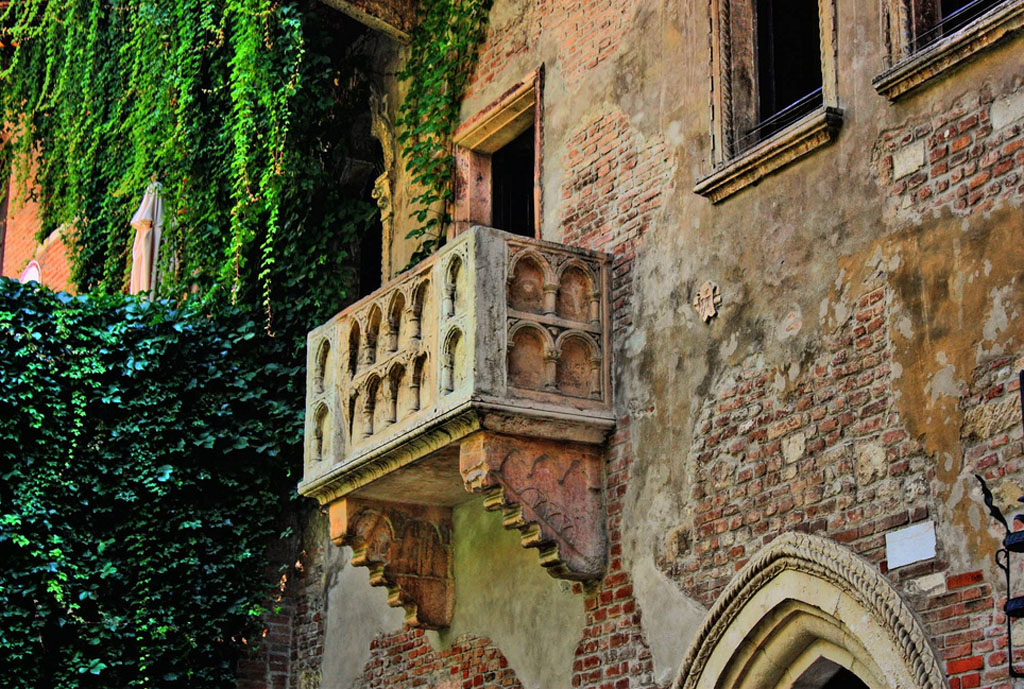Verona: Most beautiful things to do and visit

Art and history in Verona, the city of Romeo and Juliet, A Love Story
Here we suggest a route that will guide you to discover what you can see in Verona in a simple and short weekend or during a prolonged stay in our farm The Constants. You will not only see the city, but also enjoy its province, alternate excursions on Lake Garda in the days of sport fishing in the ponds where the countryside is dotted, to combine cultural activities with moments of relaxation and wellness in spas next to our farm. You can choose one of the restaurants that I recommend to Verona and surroundings. Enjoy the reading! I say that because I insinuates that people do not read. Far from it. Those seeking information and authentic law and reads a lot.
What to see in Verona: All the more interesting attractions of the capital city Scala
HOW TO REACH VERONA
From our farm The Constants (Via Giare, 1 Caldiero, east Veronese) Verona can be reached in ten minutes via the southern ring road that can take you from just outside our house. The exit for Verona historical center is Borgo Roma. In Verona you can buy the Verona Card, which will allow the free visit to many attractions of Verona and many concessions. www.veronacard.it
SOME HISTORICAL EARNINGS
Before you list and describe the main features of each monument, church or palace to see in Verona dedicate a few words to his story. Those who have already read some of our itineraries we confirmed to have greatly appreciated the brief history preceding the route real because they give a global view of the visit to the place of destination and help to understand and enjoy its beauty.
Verona adage should be visited because it is worth it. Lake Garda is like an arched entrance to his glories and always starts from Verona with small stinging regret of not being able to see everything ..
From Verona, and that’s the beauty of our city, then other wonderful milestones ahead: the walled towns, the Venetian Villas, the magic Riviera del Brenta, the heart of the Dolomites, Soave, Lessinia, the Adriatic, Venice, Padua , Vicenza …
As is known Verona has now entered the collective Italian, European and international level for its Arena that neither is a symbol as well as the home of the summer festival of opera (or summer opera season) and for the love story immortalized by Shakespeare’s Romeo and Juliet. I documented at length on the sources from which Shakespeare drew. It ‘a very fascinating subject, but maybe I will devote to this topic another page. A page dedicated to this playwright that I love and that made my Verona even more magical, more to see and experience.
But Verona is not only this. Verona we must learn to see the charm and what it releases its ancient and stratified history, from Roman times to the Middle Ages, from the Renaissance to contemporary art through the French and Austrian domination, the Unification of Italy in 1866, the devastation suffered during Second World War, the reconstruction after World War II, the energetic policy that made it since the second city of our Venetian for turnover.
City of love par excellence, music, theater and opera, Verona, now capital of the St. Valentine’s Day and lovers from all over Italy, is full of masterpieces. Visit the city also it means seeing and enjoying a complex urban landscape and harmonious whole in which man’s work was included in the broader framework of the nature that surrounds it. In Verona, the diversity of styles that coexist does not disturb, does not offend. The patina of the historical city unites styles gracefully. The Adige, majestic, winds between the buildings and many bridges of Verona the bypass as perfect arches. The hills behind the town give us a green charming, in a picture everything in shades of ocher, sienna, ivory, pink and red Verona.
WHAT TO SEE IN VERONA: THE STREETS, COURSES AND SQUARES
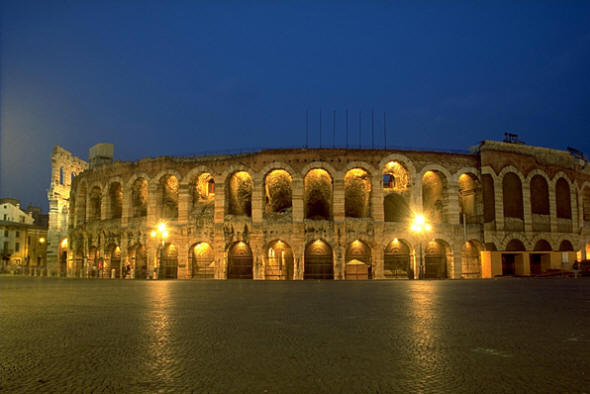
First imagine your departure from Caldiero and the arrival at the beginning of Corso Porta Nuova. Parked in the parking Citadel and walk until you reach Piazza Bra, the largest square of Verona where the famous Arena is located and in which tower the Palazzo della Gran Guardia, Palazzo Barbieri, the town hall. In front of the Arena the Liston, the historical walk of Verona, with its restaurants and cafes historical. From here you inoltrerete in Via Mazzini, the renowned shopping street leading to Piazza Erbe, Verona and from there to Piazza Dante and Piazza dei Signori.
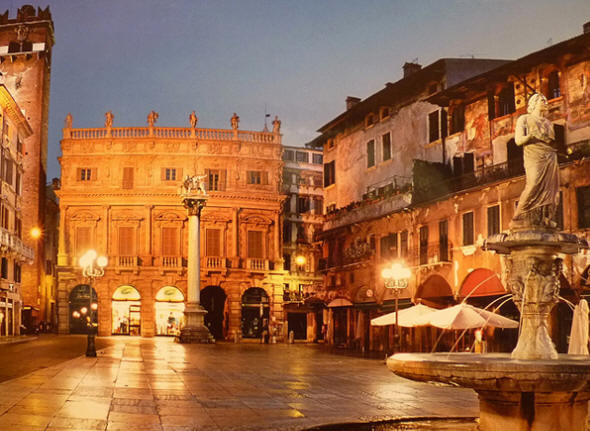
Piazza Erbe
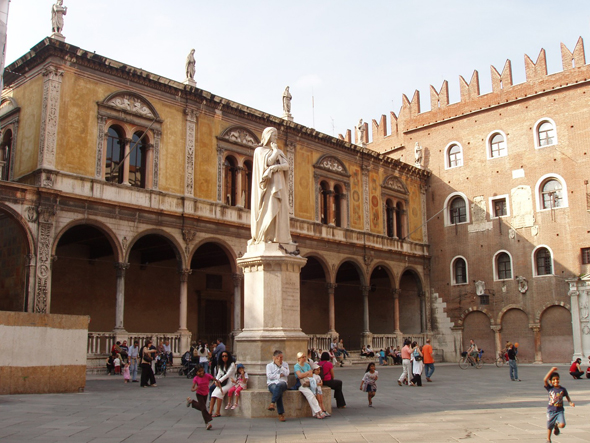
Piazza Dante
Piazza Dante along Corso Santa Anastasia you reach Via Abraham Massalongo and then over the Stone Bridge will see the Roman Theatre and its impressive Archaeological Museum. In front of you the Adige which it runs impetuous or slow depending on the season and his Lungadige.
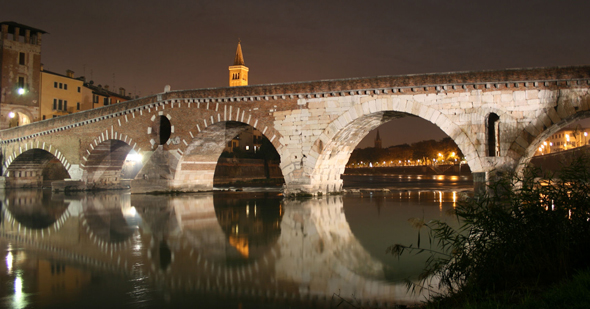
Stone Bridge
Crossing Stone Bridge and taking the Via Massalongo and Corso Santa Anastasia, you’ll go straight in Corso Porta Borsari, the Door of the Borsari and will pass at the end of Corso Cavour right will welcome the Roman Arch of Gavi and Castelvecchio.
In front of Castelvecchio, Via Roma will bring you back in Piazza Bra. Castelvecchio along the San Zeno Regaste arrive at the Church of San Zeno, Bishop Moor, patron of the city of Verona.
This is a route that can give you the bare idea of the path to program and follow a visit to Verona for even one day or a few hours.
There now follows a route much more detail in which to insert every street, square and during the description of the monuments, palaces and churches of the most beautiful and prestigious in Verona of which are in fact the most popular attractions. From time to time we will show you some little shops or some special restaurant where you can stop for a lunch or a dinner, before returning to The constants are waiting for you where your elegant, quiet room and a good night’s sleep, until breakfast the next day, carefully prepared for you from the eight.
WHAT TO SEE IN VERONA: MONUMENTS, CHURCHES PALACES
WHAT TO SEE IN PIAZZA BRA
Here we are in Piazza Bra, one of the most impressive urban masterpieces of Verona. What arouses the square is a feeling of boundless grandeur. It ‘a square light, perhaps one of the brightest squares in Italy and is green. The garden that dominates its center immediately instills a sense of serenity and is always motivated by a crowd of tourists and Verona attracted by its beauty.
The shape of the square was created in about two millennia of history. Arena majestic arches remind us of the Rome Empire, the gates of the Bra and the pentagonal tower date back to the Middle Ages travagliatissimo Verona.
The Palazzo della Gran Guardia instead takes us back to the Renaissance-inspired Sanmicheli (Domenico Curtoni) and Palazzo Barbieri to neoclassicism.
We cross the square past the central fountain and the monuments to the fallen for freedom and to Vittorio Emanuele II, one of Salazzari, the other of the villages. Beyond the gates of the Bra ‘left from Corso Porta Nuova interesting to see the Lapidary Museum of Verona.
The square is a real review encyclopedic styles together in happy harmony. We stay in one of the historic cafes of Liston for coffee, ice cream or a drink. The Liston is the most loved by Veronese, a meeting place and promenade, unifying and joyful, teeming with people until after midnight as Goethe pointed out already in 1786 …! And what of our Roman amphitheater, the Arena di Verona? International symbol of the city, the Arena was built in the first half of the first century, outside the walls of the urban area.
Gallieno included it in 265. Originally the Arena had two fences and the outer high and then fell. He saved only a short section today called “wing”. The innermost instead remained intact and can be seen today with two rows of 72 arches made of blocks of white and pink stone of Verona and topped with strips of stone and brick.
During the imperial period the arena was elected headquarters of gladiatorial games; during the barbarian invasions the amphitheater went into decay but retained until the tenth century its outer boundary.
During the twelfth century the outer wall fell because of an earthquake and other disasters. Many marble blocks were used to build other public buildings, and only towards the end of the sixteenth century the Venetian dominion, concerned about the failure of four of the interior arches (immediately rebuilt and today recognizable by their lighter color) began a continuous series precious and massive restoration also of the tiers of the auditorium. The interior of the Arena today, elliptical, seems to be slightly smaller than the original. Over the centuries the Arena served as a place of legal wrangles, type chivalrous tournaments, bull hunts, exhibitions of various kinds, festivals and art shows of comedians.
In the nineteenth century and Antonio Bartolomeo Giuliari Pompeii it caldeggiarono strongly conservation and from 1913 to now the arena, as it is known, is the seat of our sublime opera season at the Arena or summer festival as well as a venue for concerts of light music, rock and pop. Admission is free with Arena in Verona Card. For visits arena through fine opera season consult the website of the Foundation Arena Verona because I am sure that the visiting hours are programmed to allow early access for spectators. In principle, and if I remember The Arena is open every day except Monday from 9 to 19 and from 9 to 15:30 in the days of representation. Piazza Bra you can access the Via Mazzini, the shopping street of Verona.
Verdi opera par excellence, the Arena di Verona has launched the greatest voices of opera; Maria Callas was born as an artist right in Verona. I remember the tenor Luigi Zenatello Verona, which was famous throughout the world, when he realized the extraordinary acoustics of the amphitheater of Verona possessed; with a group of friends gave birth to the first performance of Verdi’s Aida setting up, as a joke on stage, in about a month .. Aida was staged in August 1913 !!! Thus was born the myth of our Aida Arena and since then it became a bit ‘symbol.
Since 1977 with the Summer Festival, the lyrical body swelled from autumn to spring his artistic career and decided to organize at the Philharmonic theater a series of concerts, ballets and operas dedicated more to the public Verona and abroad. Even the summer theater of the Roman Theatre originated by chance thanks to the intuition of a Veronese became famous more abroad than in his home town, as often happens. The merit of the birth of the theater season of the Roman Theatre is due to the theater critic Renato Simoni, who in 1948, at the invitation of the then mayor in office, agreed to be the director of the first work that marked the relationship between the theater and Shakespeare, “Romeo and Juliet “. The then assistant director of Simoni was a young Streheler! Since then the Roman theater accounted for virtually almost all the repertoire of the English playwright. Jazz was born then Verona and the fervent activity of the Roman Theatre continues today, in the same vein of its glorious past.
PIAZZA BRA A CASTELVECCHIO
One of the most prestigious monuments to see in Verona is undoubtedly Castelvecchio reach Piazza Bra along Via Roma, a street full of shops, bookstores, cafes and ice cream parlors. I remember the historical library Rome, one of the most well-stocked libraries and combative of Verona of my eighties. Home to events, discussions and debates nature of literature, philosophy and politics, a venue for exhibitions of art and place of choice for the presentation of new and emerging books, was distinguished by the sympathy and culture immense and far-sighted owners. Girlish I spent the afternoons dilating the time as happens to you when you’re at the cinema and you are viewing a movie that you’re passionate about and fascinates you. I do not know if it still exists. I will look into. But along Via Roma search it left after the ice cream and after the cinema Philharmonic … maybe some traces remained!
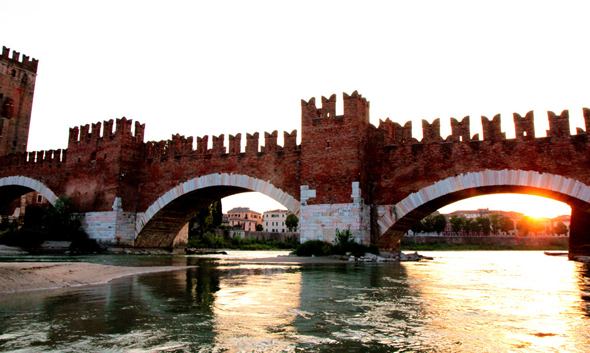
But what characterizes Castelvecchio? Located on the first bend of the river Adige, with its square towers and crenellated walls of red brick inverdito ivy climbing Castelvecchio it was built initially for fear but for ambition, the lords of Verona, the Scala or the Scala family, in this case by Cangrande Della Scala initially and then by Cansignorio in the middle of the fourteenth century, except for the tower and the bridge across the Adige, which instead are attributed to design G.Bevilacqua (1376).
The castle-fortress was originally called St. Martin’s since stood on the ruins of a small church, St. Martin in Aquarius. He took the name of Castelvecchio in the period when Galeazzo Visconti had built the new castle of San Felice.
During the Venetian rule, the castle languished and was used as an arsenal, barracks and prison and in any case it was used for military purposes. It suffered extensive damage with Napoleonic era killing of blackbirds, decrease the height of the towers and the town-closing loopholes. Antonio Avena in the 20s of the twentieth century began to recover by the shape of the castle now dejected.
Then came World War II that destroyed the right wing, his music room and frescoes by Veronese school and it was only after the war that a careful restoration at restoring the original structure allowed the consolidation and the subsequent improvement of the castle. During these “works” came to light the remains of the ancient church of St. Martin. Today it houses the Municipal Museum, to see, and a magnificent historic library, to read.
As an arc of junction for communication and escape to the north built Scaligero Bridge Scaligero and Castelvecchio leads Arsenal. The bridge gives us one of the most evocative visions of Verona, a vision, a possibly imagine today only too inflated that has become a symbol of Verona and Italy, with three impressive arches surmounting the Adige, the Ghibelline battlements and pitches always romantic hideaway for lovers on the run from prying eyes …
The clear lists of white stone wrapped brick red against the gray ash water and green hills make this one of the icons typical of the memory of Verona.
Devastated during World War II, it was rebuilt using reclaimed material originally retrieved from the river bed and rises again today majestic master reimpossessatosi ancient power to give us emotions. From the bridge is a beautiful view of the church of San Giorgio.
MUSEUM OF CASTELVECCHIO
You can not leave Verona without visiting the Museum of Castelvecchio. It can be visited in a couple of hours but it is really worth.
We enter the main courtyard of the castle that was once the parade ground and we access to a fort that was built by Napoleon, now restored and embellished by sculptural inserts that come from different buildings of Verona. The fort and the ancient palace housing the Civic Museum of Castelvecchio.
Sculptures and paintings from local origins to the eighteenth century are the issues that through the exhibits you can explore and learn by visiting this museum. The works are so many that I will mention just a few, and we refer you to one of the numerous and well-made guides of Verona can be bought at the IAT of the city. The first can be found in Via degli Alpini, next to Gran Guardia Piazza Bra.
Sculpture: Lombard goldsmith, sarcophagus of Saints Sergius and Bacchus (the school of Master Nicolao, 1179), works of sculptors Veronese half of the fourteenth century.
Painting: Crucifixion of two hundred, miniature works and paintings by Veronese three hundred works of the school and teachers Altichiero Verona current international Gothic (shovel, Stefano, Pisanello), essays Venetian school represented by Bellini, by Crivelli, from Mountain, Lotto, Mantegna, Tintoretto, Pietro Longhi, Francesco Guardi, the two Tiepolo. Room devoted to Dutch and German painters. Veronese painting from the fifteenth century onwards, with works by Francesco and Girolamo dai Libri, Nicholas Giolfino, of Morone, the Caroto, a small but select number of works by Paolo Veronese, Brusasorzi, Farinati, Maffei, Bettino Cignaroli and Balestra. There is no artistic itinerary Verona more beautiful and prestigious of this.
PORT OF BORSARI AND BOW OF GAVI: ROMAN VERONA
Turn down and let Castelvecchio Corso Cavour (coming out on the right) here is the Gavi Arch, an outstanding testimony of the Roman Verona. The Arch was built by the Veronese family of Gavi in the second half of the first century and designed by Vitruvius. The Arch originally was not where it is now but the access to the bridge in front of La Scala. It devastated by the French in the eighteenth century it was reconstructed in the current location using the original material recovery.
Going beyond the Gavi Arch and the end of Corso Cavour we reach the Porta dei Borsari, Roman gate built in the late first century or so, restored by Gallienus. It marked the end of decumannus. Here were the “marketeers” the bishop to pocket the duty of the goods. Today cleverly restored leading us through the two arches in Piazza Erbe.
HERBS SQUARE, SQUARE OF LORDS
AND COURTYARD OF THE PALACE OF THE TOWN
Among the many attractions of Verona now notes these three squares are to be seen as real architectural jewels and tell us something important: the beauty of this city, my city, is in becoming more and more valuable, step by step and becoming more and more contained, more welcoming … embroidery, a chisel … These are three squares of lounges where you can sit and chat comfortably wrapped and shrouded by pure beauty. Pamper you like you were in your living room and you tell their story, discretely, stylishly, while you sip your tea at the historic Caffè Dante tastes or your “Filipinos” with toggles and spicy pretzels, cocktail historic Verona to Caffè Filippini , in Piazza delle Erbe.
From Porta Borsari you will reach Piazza Erbe along Corso Porta Borsari.
Piazza Erbe, white umbrellas … chatter of ancient housewives … .imbonitori dialettanti … restaurateurs, painters. Once the vegetable market (herbs) actually, a bit ‘as in Mantua but also in Padua and Venice, today we are selling a bit’ of everything: souvenirs, roasted chickens, roasted chestnuts, snacks, gifts, fruit and vegetables. What fascinates is the noise, the bustle, the chatter, the lives of the people who gets it this square, Verona and foreigners. The smirking waiters in bars, cafés and restaurants, that you need with joy because they feel unique, undisputed masters of a jewel, a treasure.
To the right of the “Domus Mercatorum”, all brick, built by Albert Della Scala as the venue for the trading corporations, left the homes of Mazzanti with traces of frescoes Caroto and Giolfino. Maffei palace the lights of baroque splendor. He joins the tower Gardello with the oldest clock in Verona. At the center of a Gothic tabernacle, the fountain of Madonna Verona, a mix of Roman and medieval, a column holding the Lion of St. Mark which was shot down by the French. What you see now and put back in the nineteenth century is the work sculpted by Cesare Poli. Excellent Restaurant in Palazzo Maffei Maffei, with prestigious menu and excellent wine list. It ‘a prestigious elite restaurant. The showpiece of Piazza Erbe, in my opinion.
Piazza Erbe is through the arches suspending on your head a “rib ancient prehistoric elephant” past Piazza dei Signori at the center of which stands the statue of Dante, the famous “nose” of Verona. How not to recognize it? Seriously, Piazza dei Signori is a very noble square. As a teenager I went there to give grain to pigeons, but now there are less and less … I got into the hand and the children screaming in astonishment and joy mixed with fear. Were some good thrills, chills baby …
The square is a true rectangle surrounded by buildings connected by arches on which are placed the sculptures of some of the most famous people in the history of Verona, by Scipione Maffei Girolamo Fracastoro, Onofrio Panvinio by Cardinal Henry Noris. At the center of the square and work of Ugo Zannoni (1865) is the statue of Dante, the “Ghibelline fugitive” who had his home here in Verona guest Bartolomeo della Scala. On the long side of the square in sequence: City Hall building in the Romanesque and partly Renaissance, the Scala Palace of the Captain or the Courts with tower. On the opposite side: Loggia del Consiglio and loggia by Fra ‘Giocondo, most parts of the Renaissance city. From here you can enjoy a beautiful view of the Torre dei Lamberti. Over the arches of the loggia a beautiful Renaissance house’s Caffè Dante .. The two short sides of the square are home to the south and north of the Palace of the Judges the Scaligeri Palace dating from the thirteenth century portal by Sanmicheli. Very interesting inscriptions that astonished even Montaigne … These labels at the holes in which were strung the secret denunciations against usurers, smugglers and silk powder, prohibited by law … The Lordship of Venice was always on alert.
Piazza dei Signori is passed to the courtyard of the town hall. It gasps when we see the scale of the Gothic “Reason”, the fifteenth century, slow and solemn marble to leap the series of Romanesque arches. How many marriages I saw immortalize with this scale as background and Verona so it remains in the dreams of those who have chosen to make this scenario a partnership eternal love ..
From here, if you do not suffer from vertigo and have enough breath, you can go up the Lamberti Tower with breathtaking views across Verona. Council: Time inquire exactly where the bells.
Recommended restaurant in Piazza dei Signori: “Locanda dei Capitani”, 045-594605.
THE ARCHE SCALIGERE
Among the many things to do in Verona the Scaliger are one of the most prestigious monuments. Equipped with a special magic, were the graves of the Della Scala, lords of Verona from 1260 to 1387.
Alongside the Arche, the home of Romeo, fourteenth-century crenellated building, unfortunately not open because it is filled, and the restaurant “Alle Arche”, a time Trattoria Alle Arche, elegant and refined restaurant of Verona, just steps from the House of Romeo Montague and Juliet De ‘Capuleti who will guide you in a moment.
The Arche is collected in a fairly small enclosed by a fence in marble with iron gate bearing the symbol as a recurring motif of the ladder. I am one of the most interesting examples of Gothic sculpture Verona and date from the middle of the fourteenth century. Ruskin made it the symbol of the true Gothic Verona.
In the three arks more statues of the Lord appear twice: down the gentleman lying on the sarcophagus and on the cusp appears as a knight in arms.
We have the ark of Mastiff, the Ark of Cansignorio and the sarcophagus of Bartholomew. Outside the fence we can see rise up the ark of Cangrande I: stands for craftsmanship and art in the equestrian statue of Can Grande leader whose original is located in Castelvecchio. Alongside Arche the church of Santa Maria Antica, Romanesque, was the chapel of the Della Scala family chapel. The Romeo House is located in Via Arche Scaligere n.4-2.
VIA HAT AND JULIET HOUSE:
TOURISM ROMANTIC VERONA
We leave the house Romeo to our left, we arrive in Piazza Viviani, former Square of the items, we skirt the New Theatre after which before continuing on a road to the right that leads to Via Cappello. Exactly half of it here is the entrance of the house of Juliet’s legendary heroine of Shakespeare’s tragedy, visited by thousands of tourists from around the world. Inside the courtyard is cozy and intimate, the legendary balcony, now also home to many symbolic wedding ceremonies and the statue of Juliet.
Via Cappello, this beautiful building Scala’s former property of Dal Cappello (see emblem on the keystone of the arch of the courtyard) was up to a century ago hostel foresti. In addition to the balcony and the statue of Juliet, you can visit a small and evocative theater space and a foodie fun souvenirs. Juliet’s house is open from Tuesday to Sunday from 8.30 to 19.30 and Monday from 13.30 to 19.30.
THE TOMB OF JULIET
You can not leave without visiting Verona Juliet’s tomb, a monument to see because it seals the entire route Shakespeare in Verona. Juliet’s tomb is a sarcophagus dating back to around 1200; It is located in the basement of an ancient cloister of a convent of Capuchin friars. But why the tomb was empty?
Sacrilege? Theft? None of this ….
In fact perhaps as you go saying for some time, the remains of Romeo here lay not ever, despite the legend says the exact opposite.
The first time I visited the tomb of Juliet I thought it was very nice to find it empty and open … What is resurrected ??? Hovers over Verona ??? She Romeo ???
Going out you can visit the baroque chapel of the former church of San Francesco al Corso with some good paintings by painters of the seventeenth and eighteenth centuries as the Verona Cignaroli and the Turks.
CHURCH OF SANTA ANASTASIA
The church of Saint Anastasia is one of the most interesting of Verona and is one step away from Piazza dei Signori down the Corso Santa Anastasia .The first apse left, the chapel Horses, is to be seen; retains one of the two works in painting Altichiero remained in Verona, which was his hometown. The fresco is partially covered by the tomb of Frederick Horses present in the lunette a beautiful fresco by Martino da Verona.
The work of Altichiero that you can see is a mature work and frescoes from the end of 1300. In this work the author imagines that some members of the family horses inside of a Gothic church, are recommended to the Virgin by the Saints George and James Martin. Under the fresco admire a fourteenth-century Virgin among four Saints. The second left is the apse chapel Pellegrini. The soprarco exterior is painted by Pisanello and illustrates the exploits of St. George. Inside the chapel, a group of pads Michele from Florence, terracotta and inspired by scenes from the life of Jesus.
THE DOME
The Verona Cathedral, the Duomo, is a short walk from Santa Anastasia. It can be reached lasciandosela right and heading towards Via Massalongo, crossing and then continuing straight along the narrow streets of the old town. The Cathedral is a beauty that is breathtaking. And ‘Romanesque and stands on the ruins of previous temples. It ‘was then rebuilt in the Gothic period and the Renaissance. What strikes the visitor’s eye is the porch of Master Nicolao (1139) who sculpted the same also that of San Zeno.
Stand hunting scenes and figures of the prophets. The apse complex of the Cathedral is one of the purest and most perfect creations of the Romanesque Veronese. The bell tower, unfinished, is Romanesque in the lower part, sammichelian in the intermediate and the French beans in the upper one. (1926)
Among the most prestigious works of art that you can see inside the Cathedral of Verona, we remind the paintings of Cignaroli, Morone, Falconetto and Brusasorzi.
In the first chapel on the left it is worth a special note the Assumption of Titian painted between 1535 and 1540. Do not miss the cloister of the Cathedral and the adjoining Chapter Library.
THE CHURCH OF SAN ZENO O Basilica of San Zeno Maggiore
San Zeno is one of the most beautiful churches to see in Verona, with its large square, laughing, surrounded by good restaurants and also home to a rich local market. And ‘one of the best examples of Italian Romanesque architecture although Goethe did not like … He was more attracted to beautiful classical and neo classical (Winckelmann) and so admired by Palladio in the Vicenza and Venice.
The porch of Nicolao and school shows scenes testamentary Allegories of the Months, figures of saints and scenes from the life of San Zeno. Came from the nearby Ferrara here the master Nicolao had confirmed worthy heir of the great Wiligelmo but is distinct for added sweetness of stretch.
The bronze panels of the portal are a true wonder. Also illustrate events and testament, scenes of the apostolate of the holy, biblical and allegorical figures. They are the 48 panels and 25 more the minors. They are works dating from the eleventh and twelfth century and are attributed to three different artists from Verona, the third of which is generally considered less brilliant of the first two.
The portal and the porch of the church of San Zeno recount the beginnings of national sculpture with accents still heavily barbaric.
Among the other churches that you should see in Verona we remind San Giorgio in Braida, Santa Maria Antica, San Fermo Maggiore, San Lorenzo, Santa Eufemia, Santa Maria in Organo, St. Stephen, St. John Valley, a real gem Romanesque Verona, a bit hidden from the official tour but totally unique for its beauty and artistic value.
GARDEN FAIR
Il Giardino Giusti is one of the most beautiful in Italy and beautify Palazzo Giusti. Was originally designed as an Italian garden and then was transformed into an English garden, that is more than architectural landscape.
Among its most illustrious visitors Goethe, Scipione Maffei, Joseph Addison and Andre Suares who praised the spectacular appearance, the stones and the sculptures and the magnificent row of cypress trees leading to the hill.
Remember, near Giardino Giusti in Piazza Isolo Isolo there is parking where you can find parking for a visit to the city in peace.
STONE BRIDGE AND THEATER ROMANO
Stone Bridge is located at the point where the river Adige draws a narrow passage between the houses of the city. And ‘the only roman bridge still standing since the other Bridge Postumius was torn in the sixth century by a strong flood of the Adige. It dates back to a period just prior to the Augustan age and consists of five arches that those adjacent to the left bank are Roman, half of those have been rebuilt in the sixteenth century and those adjacent to the right bank are partly Scala. The bridge was almost completely destroyed during World War but was carefully rebuilt using the original material. Stone Bridge is a beautiful view of the Roman Theatre and Castel San Pietro.
The Roman Theatre is one of the most beautiful Roman buildings to see Verona. A masterpiece that is the urban landscape. His steps are located in the first slopes of the hill of San Pietro. It dominates the facade of the church of Saints Siro and Libera and the walls of the monastery of St. Jerome in the background. The theater, built in the first century, over the centuries it suffered a thousand misfortunes: he was literally choked with debris from buildings and that over time it disguised to the point of rendering it unrecognizable. In the last century finally Andrea Monga and his son started a ‘loving restoration work, freeing it from many of the buildings that had incorporated the centuries. Today the theater is home to the summer theater, a festival of theater, music and dance appreciated by Veronese and tourists. I remember with joy the billboard of the summer 1989 I attended enthusiastic foresaw 42 evenings of prose (Moliere, Goldoni, Shakespeare) and dance performances, jazz concerts and copyright. To view the program today just go to the site of Verona Summer Theatre.
The Roman Theatre with an elevator you can climb to the monastery of St. Jerome. Interesting archaeological museum of the theater that houses important and rare Roman remains from Verona and surrounding areas. The Roman Theatre is one of the biggest clichés of cultural production with the Roman amphitheater in Verona and Castelvecchio.
If you are planning your next trip to Italy book hotels, flights, rental cars at best price guaranteed!


